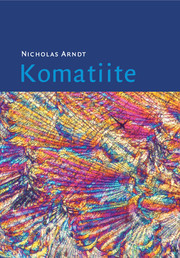Book contents
- Frontmatter
- Contents
- Preface
- Part I Background information – description of the field characteristics, mineralogy and geochemistry of komatiites
- 1 A brief history of komatiite studies and a discussion of komatiite nomenclature
- 2 Brief descriptions of six classic komatiite occurrences
- 3 Field characteristics, textures and structures
- 4 Mineralogy
- 5 Geochemistry
- 6 Isotopic compositions of komatiites
- 7 Experimental petrology
- Part II Interpretation – the manner of emplacement, the origin and the tectonic setting of komatiites
- References
- General index
- Localities
- Plate section
4 - Mineralogy
from Part I - Background information – description of the field characteristics, mineralogy and geochemistry of komatiites
Published online by Cambridge University Press: 27 August 2009
- Frontmatter
- Contents
- Preface
- Part I Background information – description of the field characteristics, mineralogy and geochemistry of komatiites
- 1 A brief history of komatiite studies and a discussion of komatiite nomenclature
- 2 Brief descriptions of six classic komatiite occurrences
- 3 Field characteristics, textures and structures
- 4 Mineralogy
- 5 Geochemistry
- 6 Isotopic compositions of komatiites
- 7 Experimental petrology
- Part II Interpretation – the manner of emplacement, the origin and the tectonic setting of komatiites
- References
- General index
- Localities
- Plate section
Summary
Introduction
The mineralogy of unaltered komatiites is remarkably simple. Only olivine crystallizes abundantly and its composition is tied closely to that of the komatiite liquid. During the early stages of crystallization, chromite, and in some cases Ni–Fe sulfides, accompany olivine, but they are normally very minor components. Other silicate minerals crystallize at a later stage, and they are normally confined to the matrix between olivine grains: this matrix consists of augite, chromite and glass in rapidly cooled lavas, and augite with or without orthopyroxene, pigeonite, plagioclase, chromite, Fe–Ti-oxides and in some cases quartz and amphibole in more slowly cooled lavas.
All komatiites are altered. In the least affected samples from Zvishavane in Zimbabwe and Gorgona Island in Colombia, pyroxene is fresh, olivine is altered to chlorite or serpentine, but only along grain margins and fractures, and fine-grained hydrous minerals patchily replace glass. In all other documented komatiites, secondary minerals replace the magmatic phases. Most if not all the olivine has been converted to chlorite or serpentine, pyroxene is partially replaced by tremolite and chlorite, and glass has completely altered to secondary hydrous minerals. In many cases the secondary minerals pseudomorphically replace the primary minerals, and little recrystallization is evident: in such samples the finest details of the habits and morphology of the original mineral grains can be recognized and the igneous precursor minerals are readily identified. In more altered samples recrystallization is more advanced and little remains of the original texture.
- Type
- Chapter
- Information
- Komatiite , pp. 98 - 129Publisher: Cambridge University PressPrint publication year: 2008



